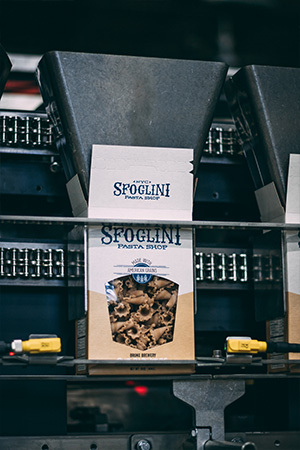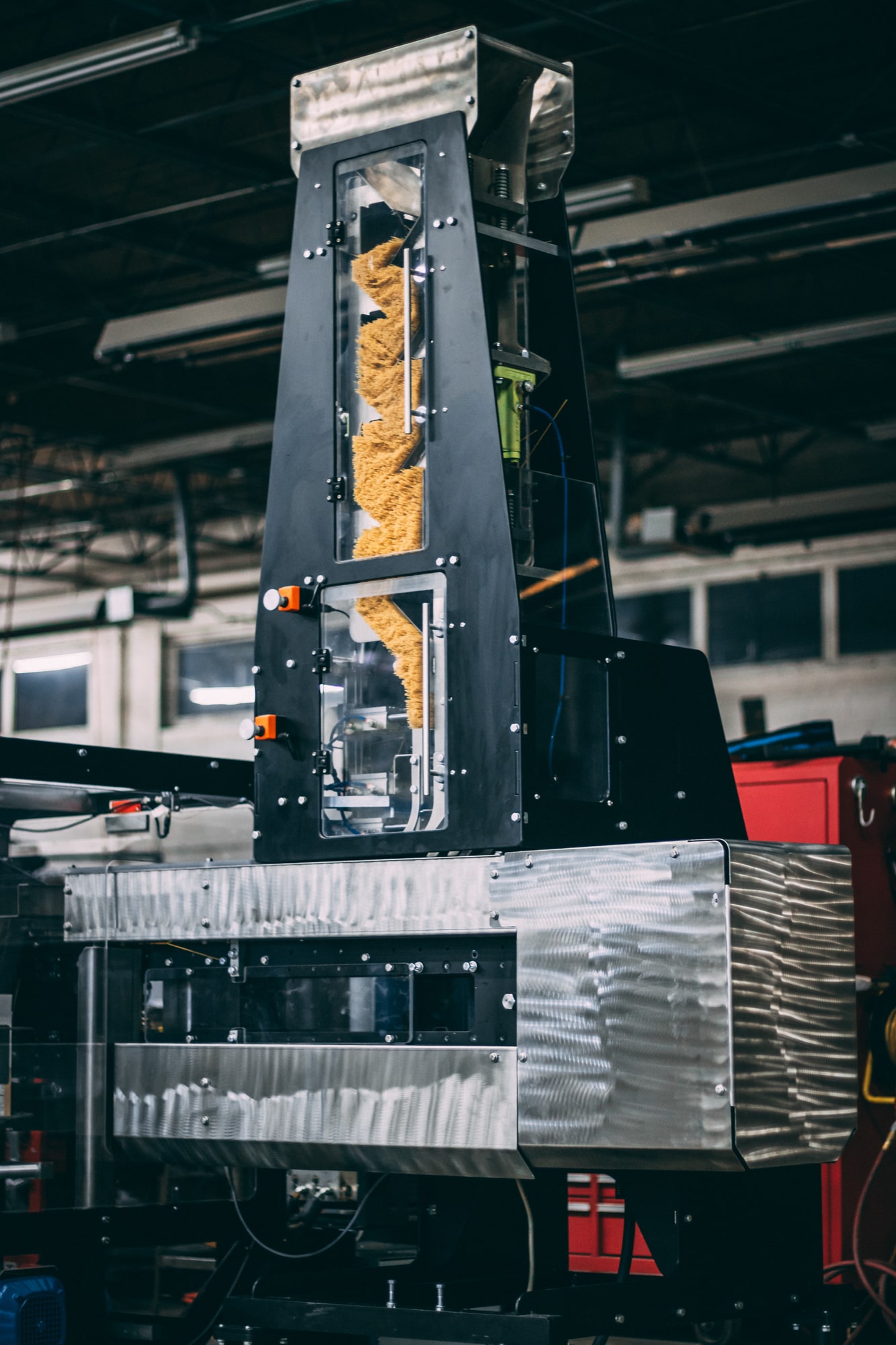What does a vertical cartoner do?
The operation of a vertical cartoning machine, or vertical cartoner, is quite simple. The cartoner process begins with taking flat, side seamed cartons one by one from a vertical carton magazine feeder. Each carton is placed by a vacuum powered rotary carton feeder into a carton "pocket" mounted to a carousal conveyor. Next, the carton bottom flaps are folded closed and sealed, employing a variety of closure styles. The cartons are then proceed to an area ample enough to hand-load or automatically load product into the cartons from both sides of the machine. After the load area, the top flaps are plowed closed and sealed, and then the finished carton is discharged from the machine.
Vertical Cartoning
Top Load Applications
Vertical cartoners are known for filling loose or free-flowing products such as pasta, rice, candy, and powders.
But they are capable of so much more.
Bags of cereal, stick packs of yogurt, sticky dried fruits, bottles of vitamins and more can be properly handled to load into cartons. This can be done by hand, with an auger, net weigh scale, combination weigher, volumetric cup filler, or custom robotic automation. We can assess your application to find the best way to carefully and efficiently transfer your product into the cartons.
Feature Options
The base equipment across all of our lines utilize the same framework and theory, allowing for us to focus on the part that matters - the best way to handle your products. Our equipment development starts with you. We form an ongoing relationship with our customers and their product lines, finding the preferred practices to produce the best looking packages while maintaining the integrity and consistency of the product inside the packaging.
Almost all of our feature options are standardized equipment. Combining these standard features in the right combination, we can create a machine custom for your specific product, package, and speed. We can also provide machines with the intention to grow. As a result of our dedication to growth, you can start off with a hand-load machine now and add any of the options later to increase automation.
Stop Wasting Product
Standard programming for No Product/No Carton and No Carton/Product Bypass. This ensures that product and packages aren't wasted.
Work on Equipment Safely
Separate high and low voltage electrical enclosures allows you to perform maintenance and repairs under power without being exposed to dangerous high voltages.
Clean and Maintain with Ease
Open frame design allows debris to fall straight to the floor without obstruction and lexan guard doors are easily removed for optimal access during maintenance and cleaning.
Building Block Design
Fully Convertible for Your Needs Today, Tomorrow,
and the Future
Our knack for simplicity coupled with our expertise in filling and handling has led us to design our equipment so that all features can easily bolt-on. To adjust to your needs, you may add auxiliary equipment from the Yeaman Arsenal, or your own at any point in your equipment's lifetime. You can create different configurations by adding and removing product and package handling features. In essence, you can convert your machine to run loose fill, stick packs, kits and more all on a single machine!
Quick Changeovers
The changeover times on our vertical cartoners are quick for one individual to perform, run to run. While many of our competitors offer adjustable carton carriers, we have found that our tool-less quick-change pockets simplify the entire changeover procedure. This process of carton handling is to manufacture a pocket holder to the exact size of the carton itself. By doing so, this enables the machine to perform the necessary operations of folding, filling and sealing the carton and produce the squarest and best possible seal for a presentable package.
Switching out individual carton carrier pockets accounts for two of the three carton dimensions addressed during changeover - the length and width of opening. Next, the carriage height is adjusted with a handwheel to a dimension marked to match the height (depth) of the carton. The following mechanical adjustment is on the magazine. Using a handwheel, simply adjust to the marked dimension that accounts for the new width of the flat carton.
The last procedure required for change-over is choosing the new recipe on the HMI touch screen. This will adjust programming settings such as timing and glue patterns for your next carton run. With these simple procedures there is no extra time spent debugging your new settings because they are already in their exact locations.
Standard Seal
Auto Bottom
Tuck and Seal
Reverse Fold
Fifth Panel
Reverse Tuck
Economy Seal
Straight Tuck
Gable Top
Sift Proof
| Model A | Model B | Model C | Model D | Model E | ||
|---|---|---|---|---|---|---|
| Standard Carton Sizes Length of Opening x |
6 Size Ranges Between MIN .75" x .25" x 1.25" MAX 7.75" x 2.5" x 11" See All |
4 Size Ranges Between MIN 2" x .75" x 2.5" MAX 11" x 3.5" x 12" See All |
2 Size Ranges Between MIN 5" x 2.5" x 6" MAX 16" x 9" x 17" See All |
|||
| Extended Carton Sizes Length of Opening x |
MAX 7.75" x 7.75" x 11" |
MAX 11" x 11" x 12" |
MAX 16" x 16" x 17" |
|||
| Speed Actual Rates Determined |
Variable to 533/cpm | Variable to 1,166/cpm | Variable to 180/cpm | Variable to 360/cpm | Variable to 75/cpm | |
| Motion |
|
|
|
|
|
|
| Machine Sizes Length x Width |
145" x 76" | 155" x 86" | 216" x 94" | 228" x 106" | 372" x 188" | |
| Additional Length Increments May Be Required Based |
15" | 30" | 18.75" | 37.5" | 37.5" | |
| Working Elevation Where Product Enters the Carton |
36" | 40" | 50" | |||
| Standard Construction |
|
|||||
| Optional Construction |
|
|||||
| Controls |
|
|||||
| Electrical Power Requirements | Wired To Your Plant's Specifications | |||||
| Pneumatic Power Requirements | Approx. 8 CFM 80 psi | |||||




